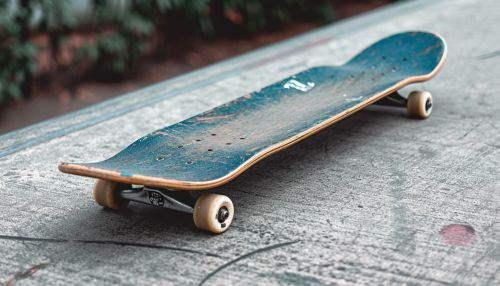Skateboarding
History
Skateboarding originated in the late 1940s or early 1950s when surfers in California wanted something to do when the waves were flat. This was called "sidewalk surfing" - a new wave of surfing on the sidewalk as the sport of surfing became highly popular. No one knows who made the first board; it seems that several people came up with similar ideas at around the same time. The first manufactured skateboards were ordered by a Los Angeles, California surf shop, meant to be used by surfers in their downtime. The shop owner, Bill Richard, made a deal with the Chicago Roller Skate Company to produce sets of skate wheels, which they attached to square wooden boards. Accordingly, skateboarding was originally denoted "sidewalk surfing" and early skaters emulated surfing style and maneuvers, and performed barefoot.
Design and Construction
A skateboard is a type of sports equipment used primarily for the sport of skateboarding. It usually consists of a specially designed maplewood board combined with a polyurethane coating used for making smoother slides and stronger durability. Most skateboards are made with 7 plies of this wood. A skateboard is moved by pushing with one foot while the other remains on the board, or by pumping one's legs in structures such as a bowl or half pipe. A skateboard can also be used by simply standing on the deck while on a downward slope and allowing gravity to propel the board and rider. If the rider's leading foot is their right foot, they are said to ride "goofy;" if the rider's leading foot is their left foot, they are said to ride "regular." If the rider is normally regular but chooses to ride goofy, they are said to be riding in "switch," and vice versa. A skater is typically more comfortable pushing with their back foot; choosing to push with the front foot is commonly referred to as riding "mongo."


Skateboarding Styles
Skateboarding has several major styles, each associated with a certain type of terrain and a series of tricks. The dominant styles today are street and vert (a type of vertical skateboarding), along with other less popular styles such as freestyle and downhill. However, skateboarding has become a platform for many to create their own style based on their personal preference of tricks and terrain.
Street
Street skateboarding involves the use of urban obstacles like stairs and their handrails (aka 'street furniture')—these can be both public and private property. Some of the most popular and influential street skateboarders of the '80s and '90s were Natas Kaupas and Mark Gonzales, both of whom were true pioneers of this form of skateboarding, as well as being influential in the evolution of the skateboard deck itself.
Vert
Vert skateboarding has its genesis in "pool riding" - the riding of skateboards in emptied backyard swimming pools - which was done when the ocean waves were flat, no surf was available. This style of skateboarding, which was pioneered and made popular by Tony Alva, became a major focus in the late '70s and early '80s. This style of skateboarding is characterized by high-speed and aggressive moves, with riders often reaching heights of over 10-15 feet above the ramp surface.
Freestyle
Freestyle skateboarding is one of the oldest styles of skateboarding and was intermittently popular from the 1960s until the early 1990s, when street skateboarding became predominant. Freestyle skateboarders often use their boards to perform tricks on a flat ground surface, in a style that is not merely a recreation of vert or pool skateboarding.
Downhill
Downhill skateboarding is a style that is primarily focused on the art of carving and sliding down hills. In downhill, the rider uses gravity to descend down hills by standing on a skateboard and rolling down. It is often practiced on long, steep hills with longboard skateboards.
Skateboarding Culture
Skateboarding culture can be divided into two main groups: the punk-skate culture and the hip-hop skate culture. The punk-skate culture is predominantly white and suburban, with an aggressive attitude and rebellious, anti-establishment views. The hip-hop skate culture is more diverse, with a significant minority presence and a more laid-back, urban attitude. Both cultures place a high value on individuality, creativity, and a certain 'do-it-yourself' attitude.
Skateboarding in Popular Media
Skateboarding has been a popular theme in American popular media, including movies, music, and fashion. It has been featured in numerous films, including the 1986 film "Thrashin'" and the 2005 documentary "Dogtown and Z-Boys." Skateboarding has also been a recurring theme in music, particularly in punk rock and hip-hop. Many musicians, including Avril Lavigne and Lupe Fiasco, have referenced skateboarding in their songs.
Skateboarding and the Law
In many areas, skateboarding is seen as a public nuisance, and has been outlawed on many city streets and sidewalks. This has led to a significant amount of conflict between skateboarders and law enforcement officers. Many cities have responded to this by building public skate parks, where the sport can be practiced legally and safely. However, these parks are often criticized for being poorly maintained, and for not being challenging enough for experienced skateboarders.
Health and Safety
Like all sports, skateboarding carries with it certain risks. These risks can be minimized, however, by wearing appropriate safety gear, including helmets, knee pads, and elbow pads. In addition, it is important to learn proper skateboarding techniques to avoid injury.
